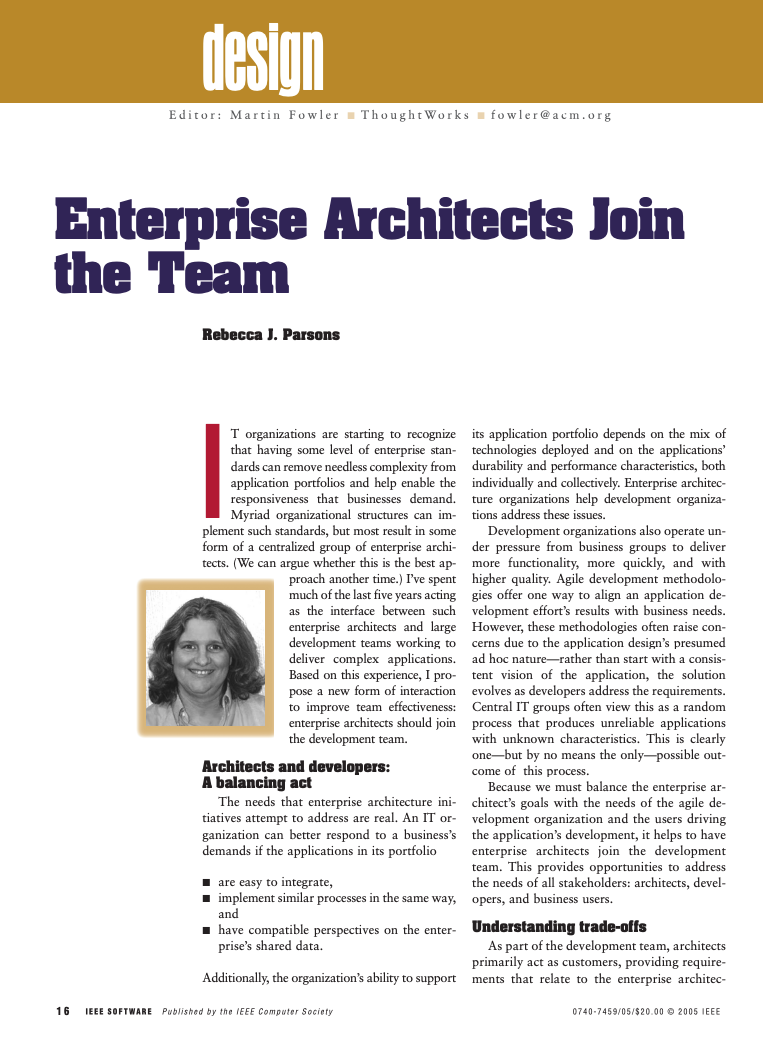tagged by: ieeeSoftware
From 2001-2005 I edited a column on design for IEEE Software. As well as writing several columns myself, I was able to rope in a very distinguished group of contributors.
Enterprise Architects Join the Team

Enterprise Architecture groups often get separated from day to day development. This can lead to their knowledge of development work getting out of date and development teams not taking a broad company-wide perspective. Having seen this happen frequently my colleague (Thoughtworks CTO) Rebecca argues that enterprise architects can be much more effective by joining development teams.
Design to Accommodate Change
Table driven techniques to allow systems to change without major code changes.
Your Coffee Shop Does Not Use Two-Phase Commit
Baristas don't do synchronous processing - their reasons may be reasons for you to go asynchronous too.
Before Clarity
Clear code is good, but should you sacrifice clarity for testability?
Fail Fast
If software's going to go south, Jim explains in this column why it should collapse as fast as possible.
The Most Important Design Guideline?
Everyone has their own list of important design guidelines. Scott concentrates on interfaces and how to design them so they are easy to use correctly and hard to use incorrectly.
MDA: Revenge of the Modelers or UML Utopia?
At OOPSLA 2003 Dave Thomas (the founder of OTI) gave a thoughtful and powerful critique of Model Driven Architecture. In this column he explains why he thinks a universal model-driven approach is likely to fail, and points out that the UML and Domain Specific Languages still have value.
Continuous Design
The rising popularity of refactoring, tools such as JUnit, and agile methodologies such as Extreme Programming (XP) has brought a new style of design into view. Continuous design is the process of using refactoring to continuously improve a program's design. In this column Jim discusses his experiences with continuous design, in particular with design issues that seem tricky such as internationalization and transactions.
Data Access Routines
A common part of encapsulation, particularly with object-oriented systems, is hiding data structures. Yet it's also common to expose much of this data behind data access routines. In this column I cover some guidelines for writing data access routines. However don't forget that if you can leave the data hidden, that's usually better.
Who Needs an Architect?
What is architecture, and who exactly is an architect? These are questions that seem to get everyone very heated. So in this IEEE Software column, I let Ralph Johnson explain about architecture: with a definition that matches all others in a way that nobody agrees with. I also talk about two sub-species of architect: Architectus Reloadus and Architectus Oryzus.
The Difference between Marketecture and Tarchitecture
When we think about software architecture, we usually think about its technical architecture. But there's also another important architecture - the one we use to communicate with the customers of the software: the marketing architecture. Neglecting this “marketecture”, and its relationship with the “tarchitecture”, can get development projects into a lot of trouble.
Components and the World of Chaos
Why chaos theory suggests that component assembly may not be as easy as it's cracked up to be.
Patterns
My IEEE column on the valuable contributions that patterns can make to understanding software design.
When to Make a Type
Guidelines on when to make a new user defined type (or class) for values.
Using Metadata
You can use metadata based approaches to remove the pain from tedious data oriented tasks.
How .NET's Custom Attributes Affect Design
Jim and Alexei took a leading role in developing a new version of NUnit. From this they reflected on how design is affected by the new .NET language feature of attributes.
Yet Another Optimization Article
It always surprises me that many well-established principles about performance optimization aren't very well known. This article is yet another attempt to cover these.
Public versus Published Interfaces
Many modern languages make a distinction between public and private features in a module. A distinction that doesn't get made so often is between public and published features: and that may be a more important distinction.
Avoiding Repetition
It's sometimes quite remarkable how the simple rule of avoiding repetition in software can lead into good design
Separating User Interface Code
One of the first lessons I learned was to always keep user interface code separate from anything else. Not just is this still good advice, it's surprising how often it's forgotten.
Protected Variation: The Importance of Being Closed
Craig's spot in the column looks at the importance of the Open-Closed principle and Protected Variation, and why Parnas's information hiding is more than encapsulation. He also gives some tips on ways to implement a protected variation.
Reducing Coupling
Thinking about how to visualize and reduce coupling.
To Be Explicit
Often designs techniques are used to make a system more flexible, but end up being harder to work with. One of the reasons is that explicitness is a property that often gets forgotten in design.
The Test Bus Imperative
Testability is such an important virtue that you should make architectural decisions to improve the testability of a system.
Module Assembly
Modular programming is not just about programming to interfaces, it's also about assembling modules together without the various modules knowing which concrete modules they are talking to.
Modeling with a Sense of Purpose
The kinds of model you draw depends on the purpose that you want to put them to. John describes a useful distinction between conceptual, specification, and implementation models.
